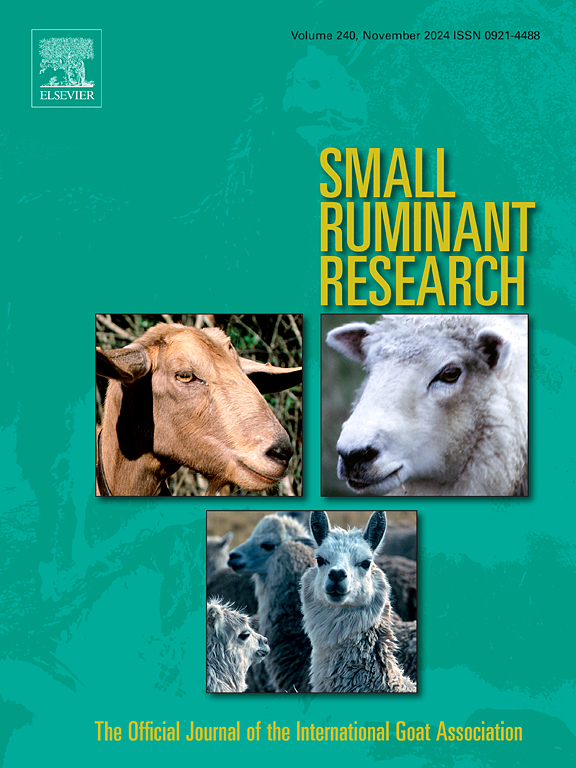公羊睾丸保温24或48 h引起的热应激迅速损害附睾精子质量,降低精子发生
IF 1.6
3区 农林科学
Q2 AGRICULTURE, DAIRY & ANIMAL SCIENCE
引用次数: 0
摘要
哺乳动物的睾丸必须低于身体核心温度3-5℃才能产生形态正常的精子。目的是研究阴囊保温诱导的热应激对附睾精子的影响以及热应激对精子发生的影响。我们假设:(1)睾丸温度升高会损害附睾中的精子;(2) HS暴露对精子细胞的影响较大。用阴囊保温24或48 h的方法诱导20只生殖健全的成年公羊的睾丸HS,另设5只相似的公羊作为对照(未保温)。分别于保温后24 h、48 h、7 d、14 d进行阉割(对照组随机阉割)。绝缘使阴囊表面温度提高了~ 5 ºC。精子活力、进行性活力和动力学从24 h开始显著降低(P <; 0.01),并持续整个研究过程。附睾形态正常精子的比例在24 h时首先下降(P <; 0.01),随后在48 h (P <; 0.01)和7 d时下降(P <; 0.01);此后形态学保持稳定(P >; 0.05)。14 d时,与其他各组相比,睾丸重量(P <; 0.05)和精管直径(P <; 0.001)均有所降低。关于精管完整性(Johnsen评分),第一次下降发生在24 h (P <; 0.05),随后在14 d时更强烈地下降(P <; 0.001)。此外,精子计数在24 h时突然下降(P <; 0.05),并在整个研究过程中持续。总之,我们的假设得到了支持;睾丸HS对绝育后24和48 h的附睾精子以及7和14 d的精细胞发育产生了直接的有害影响,减少了精子的产生,显著降低了性病和睾丸重量。本文章由计算机程序翻译,如有差异,请以英文原文为准。
Heat stress induced by testicular insulation for 24 or 48 h rapidly impairs epididymal sperm quality and reduces spermatogenesis in rams
Mammalian testes must be 3–5 ºC below body core temperature to produce morphologically normal sperm. The objective was to investigate impacts of heat stress (HS) induced by scrotal insulation on epididymal sperm and temporal aspects of HS on spermatogenesis. We hypothesized that: (1) increased testicular temperature impairs sperm in the epididymis; and (2) spermatids are severely impacted by HS exposure. Testicular HS was induced by scrotal insulation for 24 or 48 h in 20 reproductively sound adult rams, with 5 similar rams designated controls (not insulated). Rams were castrated at 24 h, 48 h, 7 d, or 14 d after the start of insulation (whereas control rams were randomly castrated). Insulation increased scrotal surface temperature by ∼5 ºC. There were marked decreases (P < 0.01) in sperm motility, progressive motility and kinetics starting at 24 h and sustained throughout the study. Percentage of epididymal sperm with normal morphology first decreased at 24 h (P < 0.01) with subsequent decreases at 48 h (P < 0.01) and 7 d (P < 0.01); thereafter, morphology remained stable (P > 0.05). At 14 d, there were decreases in testicular weight (P < 0.05) and seminiferous tubule diameter (STD) (P < 0.001) when compared to all other groups. Regarding seminiferous tubule integrity (Johnsen’s score), a first decrease occurred at 24 h (P < 0.05) followed by a more intense decrease at 14 d (P < 0.001). In addition, there was an abrupt decrease (P < 0.05) in spermatid counts at 24 h that was sustained throughout the study. In conclusion, our hypotheses were supported; testicular HS caused immediate deleterious impacts on epididymal sperm at 24 and 48 h post-insulation as well as developing spermatids at 7 and 14 d, decreasing sperm production and significantly reducing both STD and testicular weight.
求助全文
通过发布文献求助,成功后即可免费获取论文全文。
去求助
来源期刊

Small Ruminant Research
农林科学-奶制品与动物科学
CiteScore
3.10
自引率
11.10%
发文量
210
审稿时长
12.5 weeks
期刊介绍:
Small Ruminant Research publishes original, basic and applied research articles, technical notes, and review articles on research relating to goats, sheep, deer, the New World camelids llama, alpaca, vicuna and guanaco, and the Old World camels.
Topics covered include nutrition, physiology, anatomy, genetics, microbiology, ethology, product technology, socio-economics, management, sustainability and environment, veterinary medicine and husbandry engineering.
 求助内容:
求助内容: 应助结果提醒方式:
应助结果提醒方式:


